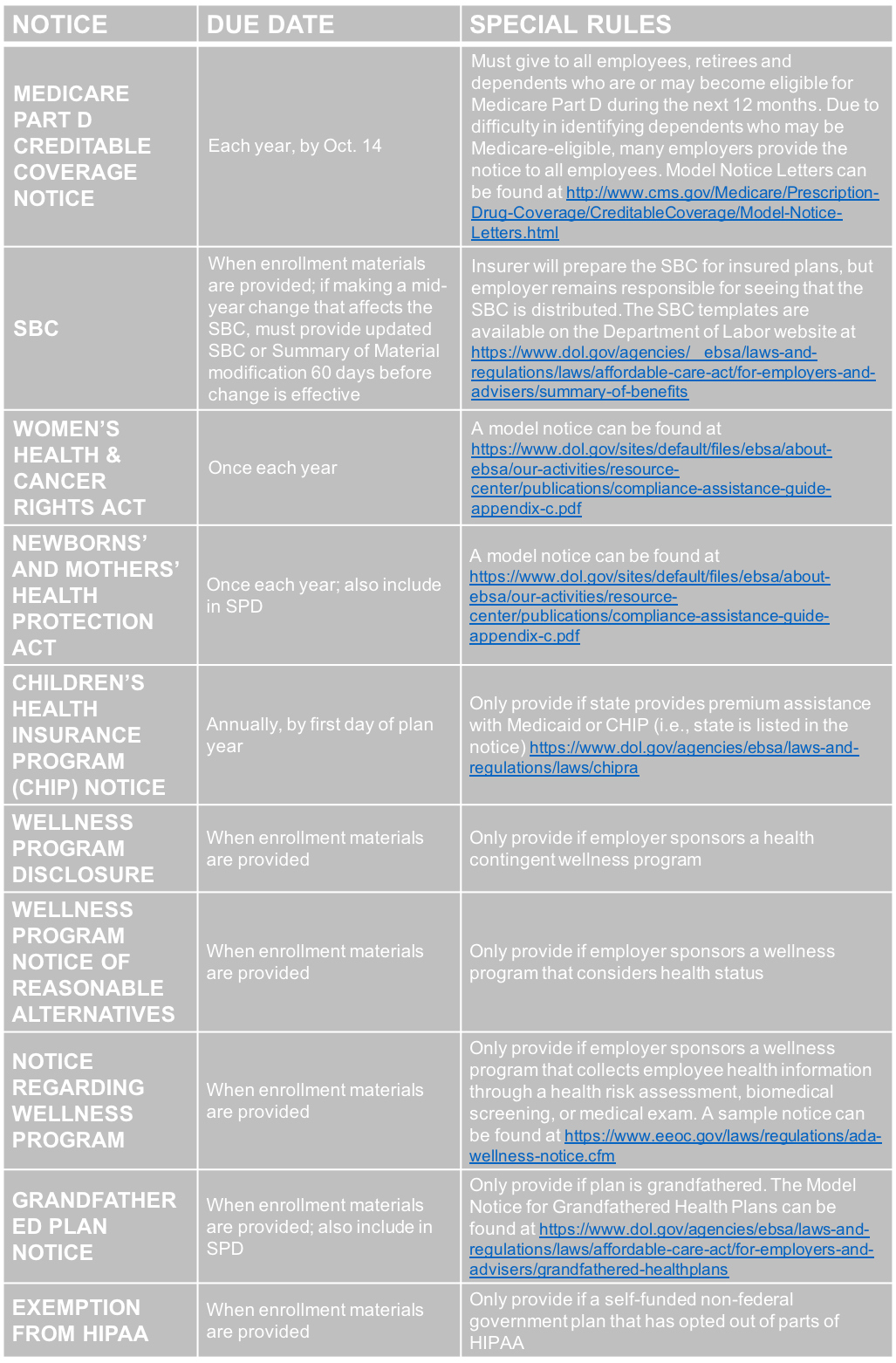An Employer’s Guide to Annual Group Health Plan Notices
 Employers that sponsor group health plans are required to give eligible employees a number of notices each year. Some notices must be given by a particular date, and some must be given as part of the enrollment packet. (This means that non-calendar year plans may need to provide Medicare Part D Creditable Coverage notices this fall, and the other notices with their open enrollment materials.)
Employers that sponsor group health plans are required to give eligible employees a number of notices each year. Some notices must be given by a particular date, and some must be given as part of the enrollment packet. (This means that non-calendar year plans may need to provide Medicare Part D Creditable Coverage notices this fall, and the other notices with their open enrollment materials.)
The chart below provides a summary of the required annual notices. Unless the chart says that a requirement only applies to a specific group, the notice must be given by all employers, no matter how small they are, and regardless whether they are a private, government, church or not-for-profit employer or grandfathered.
The General Notice of Pre-existing Condition Limitation is obsolete since pre-existing condition limits are no longer allowed in group plans. The Health Insurance Portability and Accountability Act (HIPAA) Notice of Privacy Practices only needs to be sent if it has been at least three years since the last notice was sent or if an individual requests that it be sent to him or her.
A Word document that includes models of all required federal notices except the Summary of Benefits and Coverage (SBC) can be downloaded here. (Links to the SBC templates and other available templates are in the chart, should you need them.) You should delete the notices that do not apply to your situation. You should also review each notice you do need to give, modify it as needed to describe your plan, and fill in any blanks. Sections that need customization generally are highlighted in yellow.
All of the annual notices also should be given to new enrollees. In addition, new enrollees must be given the general Consolidated Omnibus Budget Reconciliation Act (COBRA) notice (if you employ at least 20 people) and the notice of special enrollment rights. All new hires should be given the New Health Insurance Marketplace Coverage Options and Your Health Coverage notice (Exchange notice). Completing the third page of the Exchange notice is optional for employers. Completing the second page is still required, and since it includes information an employee needs to complete an application for a premium subsidy, providing this information may reduce inquiries from the Exchange/Marketplace.
Spanish versions – and originals of the English versions – of many of the notices are available on the U.S. Department of Labor website or on the Centers for Medicare & Medicaid Services website.
The plan administrator (typically the employer) needs to take steps to be sure that the notices are received. Notices may be mailed (first class to the employee’s home address) or hand delivered. Providing paper copies in a central location is not adequate. Notices may be provided electronically, as long as the employee regularly uses a computer as part of his or her job. If an electronic notice is provided, the employer must:
- Provide either electronic or non-electronic notice to each recipient describing where the notice is posted, explaining the significance of the notice and stating that a paper copy is available at no charge, with instructions on how to obtain the paper copy.
- Use the return-receipt feature, the undelivered mail feature, or a similar method to confirm that the materials are being received.
If the employee does not use a computer as part of his or her job, the employee must provide specific permission to receive a notice electronically. If you have some employees who regularly use computers and others who do not, you may distribute the notices electronically to those who use computers and provide paper notices to those who do not.
You do not need to get paper or electronic signatures from employees acknowledging that they have received the notices (although you may do this if you want to). You should always retain evidence that the notices were given, including a copy of each notice, the date it was provided, and who received it (as either a class or individually). You do not need to give a separate notice to a spouse or dependent child unless you know the family members are living apart. (A college student is not considered to be living apart.)
Some employers include notices in their open enrollment packet that are not required. That is permitted, although if the notice technically is required to be included elsewhere (for example, the Newborns and Mother’s Health Protection Act notice should be included in the summary plan description), it should also be included in that document.
Important: Notices need to be given to participants in a variety of situations. This guide only addresses notices that must be given annually to meet federal requirements.


